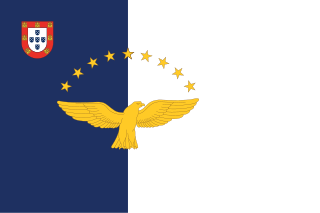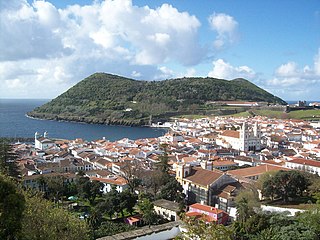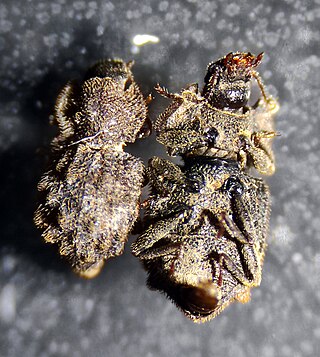
The Azores, officially the Autonomous Region of the Azores, is one of the two autonomous regions of Portugal. It is an archipelago composed of nine volcanic islands in the Macaronesia region of the North Atlantic Ocean, about 1,400 km (870 mi) west of Lisbon, about 1,500 km (930 mi) northwest of Morocco, and about 1,930 km (1,200 mi) southeast of Newfoundland, Canada.

Hedychium gardnerianum, the Kahili ginger, Kahila garland-lily or ginger lily, is a species of flowering plant in the ginger family Zingiberaceae, native to the Himalayas in India, Nepal, and Bhutan. It is an erect herbaceous perennial growing to 8 ft (2.4 m) tall with long, bright green leaves clasping the tall stems. The very fragrant pale yellow and red flowers are held in dense spikes above the foliage. They appear towards the end of summer.

The Azores bullfinch, also known as the São Miguel bullfinch, or locally in Portuguese as the priolo, is a threatened passerine bird in the true finch family. It is endemic to São Miguel Island, in the Azores archipelago of Macaronesia in the North Atlantic Ocean.

Monte Brasil is the remnants of a tuff volcano connecting the south coast of Terceira in the central Azores, overlooking the city of Angra do Heroísmo. Monte Brasil is flanked by two bays: the Bay of Angra to its east, and the Bay of Fanal to its west, and was used as a defensive point during the history of Angra, resulting in the construction of various forts and redoubts, including the Fortress of São João Baptista overlooking the city.

Juniperus brevifolia, the Azores juniper, is a species of juniper, endemic to the Azores, where it occurs at altitudes of 240–800 metres, rarely up to 1,500 m (4,900 ft). It is closely related to Juniperus oxycedrus of the Mediterranean region and Juniperus cedrus of the neighboring Macaronesian islands. It is threatened by habitat loss.
Melicope haupuensis is a species of tree in the family Rutaceae known by the common names Haupa Mountain melicope and Pacific pelea. It is endemic to the Hawaiian Islands, where it is known only from the island of Kauai. It is threatened by habitat loss. It is a federally listed endangered species of the United States. Like other Hawaiian Melicope, this species is known as alani.

Ponta dos Rosais is a promontory located along the northwestern coast of the parish of Rosais, municipality of Velas, on the island of São Jorge in the Portuguese archipelago of the Azores.
Falbouria is a genus of flies in the family Dolichopodidae. It contains only one species, Falbouria acorensis, which is endemic to the Azores. The genus was originally named Balfouria by Octave Parent in 1933; it was renamed to Falbouria by C. E. Dyte in 1980, after the name Balfouria was found to be preoccupied by the snail genus Balfouria Crosse, 1884.
Pico da Vara is the highest mountain on the island of São Miguel, in the Portuguese archipelago of the Azores, and principal special protection of the Nature Reserve of Pico da Vara. The area around the mountain includes the largest remaining stand of the native laurisilva forest on the island, home to the critically endangered endemic Azores bullfinch.

Cyanea hamatiflora is a rare species of flowering plant in the bellflower family known by the common name wetforest cyanea. It is endemic to Hawaii, where it is known from the islands of Maui and Hawaii, and there are probably fewer than 250 plants remaining in total. It is a federally listed endangered species. Like other Cyanea it is known as haha in Hawaiian.

Cyrtandra cyaneoides is a rare species of flowering plant in the African violet family known by the common name māpele. It is endemic to Kauaʻi in Hawaiʻi, where it is known from eleven populations containing a total of under 800 individual plants. Several of these were discovered between 2003 and 2008. It is a shrub that grows 1 to 6 meters tall, bears white flowers, and egg-shaped berries. It was federally listed as an endangered species in 1996.

Euphorbia stygiana is a species of evergreen shrub in the family Euphorbiaceae, endemic to several islands of the Azores. It has a critically endangered subspecies with only 20 known remaining mature individuals in the wild.
Calathus extensicollis is a species of ground beetle from the Platyninae subfamily that is endemic to the island of Pico, Azores. It is presumably extinct, as the last recorded individual dates from 1859.
Myosotis azorica, common name Azorean mouse-ear or Azorean forget-me-not, is a plant species endemic to the Azores Islands in the North Atlantic Ocean.

The Azores temperate mixed forests is a temperate broadleaf and mixed forests ecoregion of southwestern Europe. It encompasses the Azores archipelago in the Atlantic Ocean. These volcanic islands are an autonomous region of Portugal, and lie 1500 km west of the Portuguese mainland.

Vila Franca Islet is a vegetated uninhabited islet located off the south-central coast of the island of São Miguel in the Portuguese archipelago of the Azores. The entire islet and surrounding waters constitute a protected nature reserve, while remaining a popular destination for swimming and cliff diving.

Cyrtandra heinrichii, known as ha'iwale or lava cyrtandra, is a perennial flowering plant in the family Gesneriaceae. It is found on the Hawaiian island of Kauai.

Tarphius floresensis is a beetle species in the family Zopheridae endemic to Flores Island (Azores). It is commonly named as an iron-clad beetle in English or Escaravelho-cascudo-da-mata in Portuguese. The genus Tarphius is evolutionarily old species to Azores.

Trechus terrabravensis is a beetle species in the family Carabidae endemic to Terceira Island, Azores, Portugal.
Noctua atlantica is a species of yellow underwing moth belonging to the family Noctuidae, the cutworms. This moth is endemic to the Azores.















